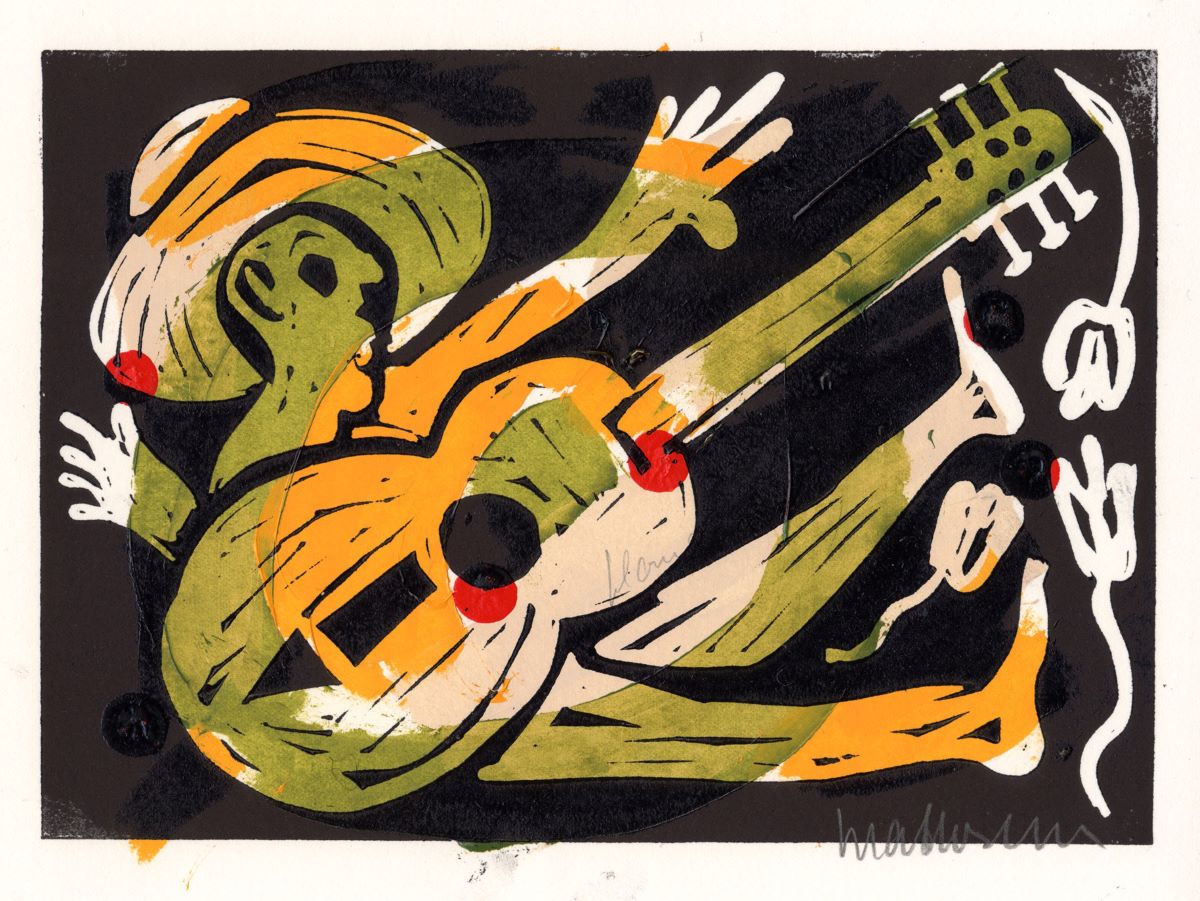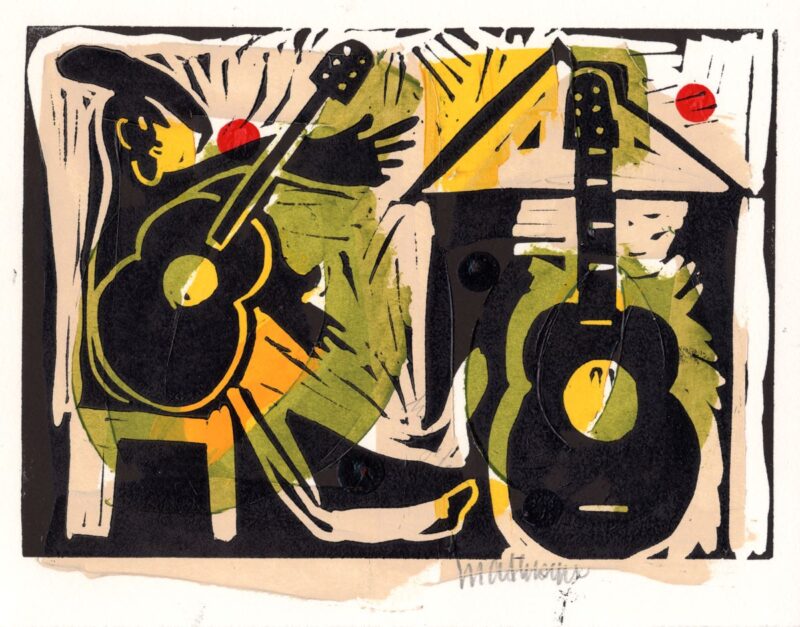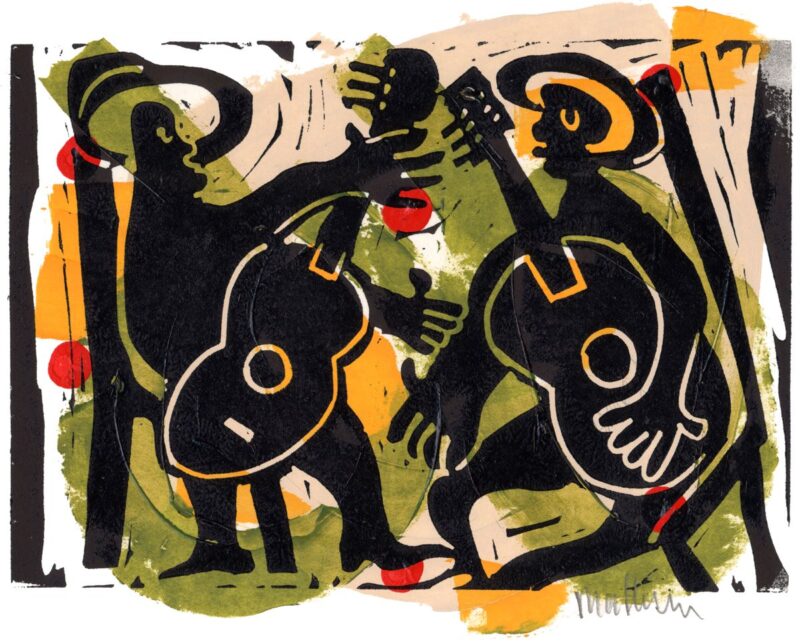2024 Update by Frank Matheis, with linoleum cut illustrations by Gert Mathiesen

The good news is that there are still at least 600 or so musicians actively performing the acoustic blues today. The acoustic blues is still alive and well in the 21st Century. When the late, great harmonica ace Phil Wiggins read that some pundits claimed that the acoustic blues was dead, he retorted most aptly, “They ought to get out more.”
There are great records being produced, concert halls and clubs filled by the musicians who are keeping the acoustic blues flames burning today. Blues Festivals still draw a good crowd and acoustic blues is still a small but steady portion of this. There is also still a fascination and strong interest in the acoustic blues over in Europe. Many American players regularly tour the continent and rely on that market as an important source of income.
Yet, the genre’s very survival, in the long term, is challenged. Undeniably, the existentialist facts are not so rosy for the long-term survival of acoustic/folk/country blues, but for now we are surviving.
Let’s start with the good news…
The Old-Timers Are Holding
Plenty of musicians are still able to make a living playing the old-time blues. Many of the musicians who were the disciples of the great originals, who learned directly from the blues musicians who reemerged during the 1960s and ’70s, and who picked up the styles, tuning and songs as apprentices from the old masters, are still active and successful today. Indeed, today they are the blues elders who have been active for up to 50 years: Taj Mahal, John Hammond, Doug MacLeod, Roy Bookbinder, Jorma Kaukonen, on and on. Then, there are the guitar virtuosos, the supreme guitarists of the genre, with a broad repertoire of folk/roots styles: Ry Cooder (when he is in a blues mood), Ed Gerhardt, Mike Dowling, Ari Eisinger, Michael Jerome Browne, Terry Robb and a few more in the heavy-hitter guitar league.
Many Superb Black Players Are Carrying the Torch
There is a core group of excellent African American players who have achieved wide ranging success and who carry on the blues tradition internationally: Alvin Youngblood Hart, Corey Harris, Guy Davis, Eric Bibb, Keb Mo, Otis Taylor, to name but a few. Some wonderful “newer” players are infusing new blood into the scene, including Jerron Paxton, the MSG Blues Trio, Dom Flemons, Valerie & Ben Turner (Piedmont Bluz), Jontavious Willis, Andrew Alli, Marcus Cartwright, Sean “Mack” McDonald, Hubby Jenkins, Tevis Hodge Jr., Jayy-Hopp, Buffalo Nichols and others.
Blues is an African American cultural contribution to the world, a black musical form. Yet, it’s not easy for Black musicians, even though the traditional blues is an inherent part of the African American experience. Black musicians can feel a form of estrangement as this music ,which had its origins in the black experience, is now in a white dominated world. The blues press, blues forums, record labels and radio DJs are predominately white (including this writer) – as is the audience. Even the one blues magazine devoted to the preservation of the African American legacy, Living Blues, is underrepresented by African American writers and critics. The blues academia, the professors of the blues, the book authors, all mostly white. A commonly heard complaint is that Black acoustic players are often relegated to second or third tier position in blues festivals while white blues-rockers take the main stage and the best slots. No wonder that black blues musicians want to hold on to the fact that they are, indeed, the authentic cultural heirs to the blues. These are legitimate grievances of black musicians.
Women Are Going Stronger Than Ever
The blues women are as powerful as ever, thanks to Rhiannon Giddens, Allison Russell, Sue Foley, Amythyst Kiah, Leyla McCalla, Shemika Copeland, Ruthie Foster, Rory Block, Erin Harpe, Valerie Turner, Maria Muldaur, Mary Flower, Albanie Falletta, Mamie Minch, Valerie June, Emily Druce, Libby Rae Watson, Eleanor Ellis, Del Rey, Janiva Magness, Lauren Sheehan, Gaye Adegbalola, Larkin Poe, Veronika Jackson, Heidi Holton, Cristina Vane, Dona Herula, and many more.
Worldwide Interest
People worldwide love the acoustic blues. Plus, there are wonderful players all over the world, especially in Europe, and increasingly in Asia, such as in Japan and even in Nepal. Like any successful cultural phenomena, the blues is now international, a cultural triumph that should be celebrated and a source of pride. A recent example is the Irish teenage fingerpicking sensation Muireann Bradley. The Blues has circumnavigated the globe, just like jazz, rock-and-roll and Classical music. People from all over the world play, feel and love the blues. To name but a few: Fiona Boys and Jeff Lang in Australia. Tanja Wirz and Rainer Wöffler in Switzerland. Michael van Merwyk, Peter Funk and Rainer Brunn in Germany. Willie Salomon in Thailand; Andrea Peeters in the Netherlands and Felcia Jangard Nielsen in Sweden. This is not cultural theft, as some like to call it, but it is a natural aspect of the powerful international cultural contribution of African Americans.
—-

Yet, there are some problems.
A White, Aging Audience
The audience demographic is aging and there has not been significant interest among the younger generation to infuse new enthusiasm into the genre. The baby-boomers of the 1960s and ’70s, who formed the first ‘folk & blues revival’ that gave a second wind to an entire set of blues musicians, are by now in their late 60s and up. With plenty of attrition and no considerable influx of new audiences, the currently active musicians are reporting a decline in listeners. Unless there is a resurgence of interest, a new blues revival or a sudden shift in the wind of popular music, it is likely that the core audience of today is the last and that the acoustic blues will experience a decline after this generation.
There has been only a tiny black audience for the acoustic blues, even during the heyday of the 1960s blues revival, and today it is minuscule, almost down to the angstrom. African American audiences left the genre decades ago, except in a few pockets in the Deep South. Most acoustic blues fans today are white men over fifty – many in their sixties and seventies. The counterculture baby boomers are aging, and they are buying less music and going out to hear live music less.
Not Much Help on the Radio
Radio is no salvation. The deep roots acoustic blues is virtually shut out of the radio. Today people can choose playlists from streaming media, but on regular radio you’ll hear a few classics here and there, but the picture is bleak in the syndicated shows, and satellite radio blues shows. Even the independent DJs focus mostly on electric blues and blues rock. There are of course exceptions, a few shows nationwide still feature the acoustic blues, but we could not fill a classroom if we tried.
Few Record Deals for Acoustic Blues
Blues record labels also report that sales of acoustic blues are so sluggish and weak that they are reluctant to sign folk blues acts. Alligator, for example, once signed Corey Harris and Cephas & Wiggins, but now shies away from country blues acts due to weak sales. Consequently, musicians are increasingly self-producing their recordings, with mixed results. Some very excellent musicians are churning out poorly produced, lackluster albums, often in studios that do not understand or know how to record acoustic music. The market is flooded with self-produced albums, many that never really get off the ground. Sadly, today this is the norm for many struggling and upcoming artists, rather than the exception, because few “not yet famous” acoustic country blues artists have the financial backing to be able to afford a professionally produced album where everything is done right. Even in cases where everything is played and recorded perfectly well, many “good” albums simply lack the energy, fire and passionate intensity of the early blues, or those produced in the 1960s and ’70s, when record labels still had an interest in the country blues.
Racialism
The blues is a musical form that has been integrated from the time of Lonnie Johnson and Eddie Lang (even if only behind the scenes). Musicians broke the color barrier, played together and learned each other’s music, maybe not openly when oppressed by Jim Crow laws but certainly they hooked up and sat in with each other when possible. This is evident by the wide-ranging repertoire of the Piedmont songsters, for example, which drew from ragtime, Country, Appalachian Mountain music, blues, gospel and even European folk songs. Music was always the true melting pot.
Today some people talk about “true blues,” not how the music is played, but by the “authenticity” of the music, which is a mere code word based on the skin color or the performer. This is simply wrong in the blues as anywhere in life. Music should be a unifying force, and not a reason to judge human beings by the color of their skin.
Old Versus New
Ostensibly, a threat to the very survival of the genre may be those who profess to know and love it the most. Admittedly, that seems like a bizarre statement. Because the acoustic blues is a very small world compared to electric blues, and the blues overall is a very small segment of the popular music culture, you would think that the genre’s survival will be carried by the true fans, the blues aficionados, the most devoted acoustic blues fans. The problem is that a sizable portion of the acoustic, folk and country blues fans only love the original old blues and tend to dismiss the new purveyors of the musical form. Of course, people can like what they want to like. Nothing wrong with that. If people enjoy only the blues of the golden era (1920s-1930s) played exactly as it was in the original 78 rpm recordings, that’s perfectly fine. We love that music! Otherwise, those songs would wither on the vine. The only way people will know and love the blues is to cherish the legacy. Everybody has a right to like and listen to what they want.
If the celebration of the past comes with the rejection of the present, there is logically a risk that there will be no future, just cultural extinction.
The problem comes in when the fans of the old blues don’t love, and even reject, the new blues for whatever reason. If the celebration of the past comes with the rejection of the present, there is logically a risk that there will be no future, just cultural extinction, that the music they love will simply be locked into a time capsule in a museum or in the Library of Congress.
At its worst, some hardcore blues purists dismiss contemporary players as “mere imitators” or they question where an acoustic blues musician is from (I recently read a very misguided review of the new John Hammond record where the writer claimed that John sounds “like a New York musician copying the Southern blues”); what the skin color is; or they categorically attack anyone who changes the music even slightly. Scathing criticism is reserved for those who don’t play it note for note as it was played 80 years ago on the original 78 rm records. The level of criticism holds no boundaries.
This phenomena among acoustic blues audiences seems to be unique in contemporary American roots & folk music. Bluegrass, Cajun, Zydeco, Celtic-American, Tex-Mex and many other roots music forms are going strong, in large part because the audiences may cherish the past but celebrate the present. Bluegrass audiences may love Bill Monroe, Lester Flatt, Ralph Stanley and Earl Scruggs, but they love and support the young players on the scene today. In Zydeco, everybody cherishes Clifton Chenier, but they still turn out for the new generation.

We Need to Carry On
So, there it is, pure common sense. Unless the blues can progress, stay vibrant and relevant today, there may be no folk and country blues in the next generation, given the demographic reality. To preserve the old blues, we need new blues – new songs, new songwriters, new interpretations, new sounds along with the originals. If we can swing that, the acoustic blues has a fleeting chance. Hopefully, folks will see that this is the point of this website.
Please check out the musicians listed here. The acoustic blues today may be summoned up by an old song lyric by Johnny Winter:
So, everyone will know.
I’m still alive and well.
I’m still alive and well,
every now and then
it’s kind of hard
To tell I’m still alive and well.